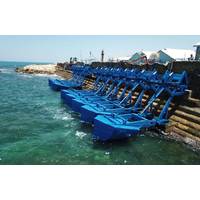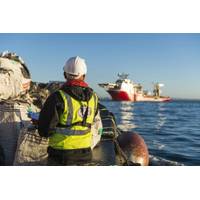RWE Dea's 30th Oil Production Anniversary in Suez
RWE Dea has achieved 30 years oil production in the Gulf of Suez. The company has produced over 640 million barrels of crude during these three decades. Ongoing investments in modern technology and infrastructure have maintained high production levels. Currently, RWE Dea is optimizing its gas lift installations in the Zeit Bay oil field.
RWE Dea has been successfully producing oil from the Ras Fanar field, just a few miles off the west coast of the Gulf, since 1984. Oil production at RWE Dea’s other two concessions in the Gulf of Suez — Zeit Bay and Ras Budran — has also been ongoing for around 30 years. From these three oilfields, RWE Dea has produced a total of 640 million barrels of oil. RWE Dea operates and owns 100% of the three concessions.
Intelligent solutions and investments in infrastructure
Production operations are carried out by the Suez Oil Company (SUCO), a joint venture of RWE Dea and the Egyptian General Petroleum Corporation (EGPC). “We are pleased to look back upon a very successful production phase together with SUCO,” said Maximilian Fellner, General Manager of RWE Dea Egypt. “For 30 years now, we have consistently leveraged new ideas to develop intelligent solutions, using the latest technology, and investing in our infrastructure. That’s how we have been able to maintain a high level of oil production from these three fields over an extended period of time while ensuring profitability,” explained Fellner.
Increasing oil production with gas lifting RWE Dea is developing the Zeit Bay field using extended reach wells drilled from land in addition
to the existing offshore wells. Currently, RWE Dea is working in the Zeit Bay field to optimize the gas lift system to increase oil production. This method involves capturing and processing the associated gas and injecting it through the annulus back into the wells to lift production. In the Zeit Bay field, RWE Dea has additionally converted wells to gas producers to extract natural gas for use in the process. The field has produced more than 230 million barrels of oil to date.
Additional wells planned in Ras Fanar The Ras Fanar field was discovered in 1974. RWE Dea has recovered roughly 114 million barrels of oil from the field since 1984. The oil is located in geological structures in the Miocene and is being recovered through two unmanned offshore platforms. The platforms are approximately 3.5 kilometers off the coast of the Gulf. The oil reaches land through a pipeline, where it is treated in SUCO facilities before the final treatment at General Petroleum Company (GPC) process facilities. Each of the two platforms is currently being used to operate 13 wells. In 2013, average production from the Ras Fanar field was approximately 4,500 barrels of oil per day. RWE Dea plans to drill two additional wells at Ras Fanar and add these to production by 2015.
Additional exploration in the Gulf of Suez
The production RWE Dea has attained from Ras Budran, the largest of the three fields, amounts to a total roughly 300 million barrels of oil to date. RWE Dea was also granted a 100% share and the operation of the neighboring East Ras Budran Offshore concession. During an initial three-year exploration phase, RWE Dea plans to conduct a 3-D seismic campaign and drill an exploration well.
In the event of new discoveries, synergies can be exploited with the existing production facilities in the Ras Budran field to rapidly and efficiently develop the new field.
The investments in the Gulf of Suez and further projects in Egypt emphasize RWE Dea’s long-term commitment to the country. Including its predecessor company, RWE Dea Egypt has already been engaged in the upstream business in Egypt for 40 years. In recent years, the company has made a number of large natural gas discoveries in Egypt and considerably expanded its portfolio through the acquisition of additional concessions. RWE Dea holds shares in 10 onshore and offshore concessions with a total area of 6,500 square kilometers.









